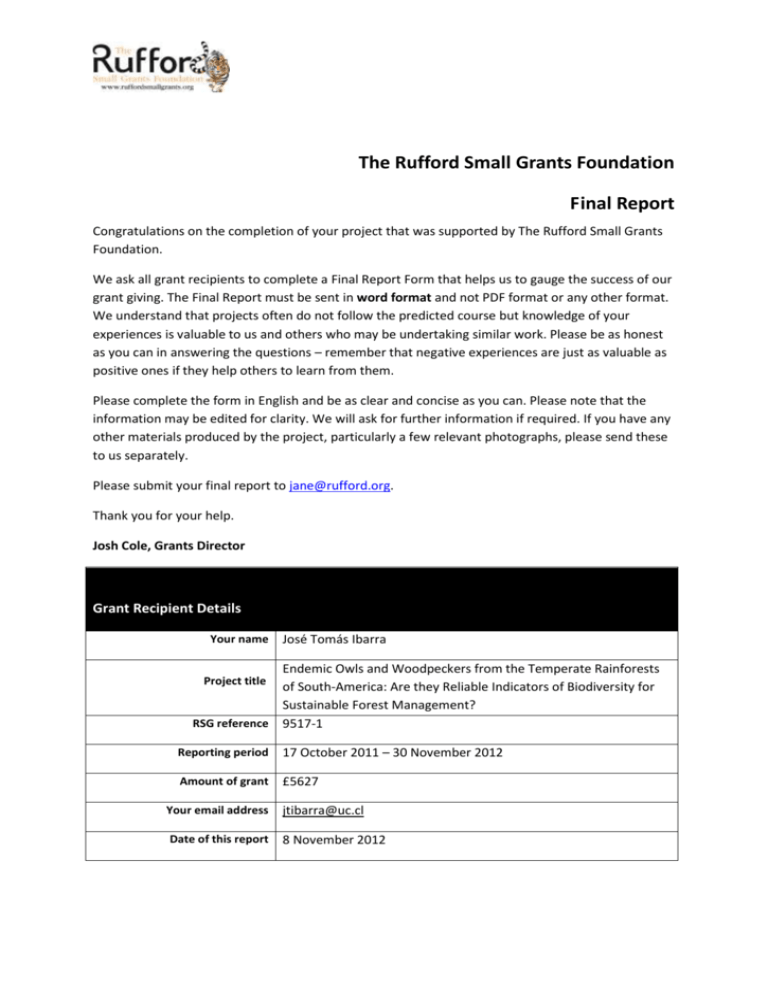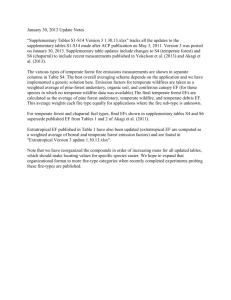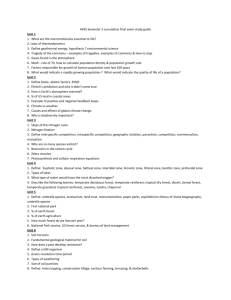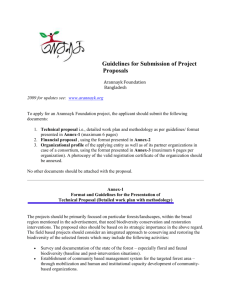Final Report - Rufford Foundation
advertisement

The Rufford Small Grants Foundation Final Report Congratulations on the completion of your project that was supported by The Rufford Small Grants Foundation. We ask all grant recipients to complete a Final Report Form that helps us to gauge the success of our grant giving. The Final Report must be sent in word format and not PDF format or any other format. We understand that projects often do not follow the predicted course but knowledge of your experiences is valuable to us and others who may be undertaking similar work. Please be as honest as you can in answering the questions – remember that negative experiences are just as valuable as positive ones if they help others to learn from them. Please complete the form in English and be as clear and concise as you can. Please note that the information may be edited for clarity. We will ask for further information if required. If you have any other materials produced by the project, particularly a few relevant photographs, please send these to us separately. Please submit your final report to jane@rufford.org. Thank you for your help. Josh Cole, Grants Director Grant Recipient Details Your name José Tomás Ibarra Endemic Owls and Woodpeckers from the Temperate Rainforests of South-America: Are they Reliable Indicators of Biodiversity for Sustainable Forest Management? RSG reference 9517-1 Project title Reporting period 17 October 2011 – 30 November 2012 Amount of grant £5627 Your email address jtibarra@uc.cl Date of this report 8 November 2012 1. Please indicate the level of achievement of the project’s original objectives and include any relevant comments on factors affecting this. Objective Not Partially Fully Comments achieved achieved achieved i. Compare oldX We have improved our understanding growth (OG), on the ecology and habitat secondary (S) and relationships for two raptor species disrupted (D) South(rufous-legged owl and Austral pygmy American temperate owl), two woodpeckers (Magellanic forests, quantifying woodpecker and Chilean flicker) and the use of these one tree-runner that also excavates its forest types by own cavities (white-throated tree endemic owls and runner). woodpeckers. We conducted 556 owl and woodpecker surveys over 5 months (austral breeding season) at 95 sites located along an environmental gradient of forests from 230 to 1,400 m. Each site was surveyed six times with a few exceptions because of logistic constraints. Although data are still under analysis, we are addressing methodological difficulties of previous studies using occupancy models that account for detectability of focal species. Preliminary results indicate that the rufous-legged owl, Austral pygmy owl and the Magellanic woodpecker, show higher occupancy probabilities of oldgrowth forest stands. Our preliminary “best candidate” models suggested that rufous-legged owls and Magellanic woodpeckers are forest-specialist species that inhabit a more specific range of habitat characteristics than Austral pygmy owls (the latter two being forest facultative species). ii. Determine how X We hypothesised that owl occupancy human land-use probabilities are functions of habitat practices (across characteristics acting hierarchically spatial scales from from the stand to landscape scales. the standto At the site level, we established 130 landscape-levels) vegetation plots were we quantified affect occupancy stand plant composition and structural patterns of owls, components (e.g. canopy cover, snag woodpeckers and density, understory density, density of other co-occurring coarse woody debris, etc). avian species. iii. Assess the efficacy of the rufous-legged owl (i.e. regulator of food webs) and of the Magellanic woodpecker (i.e. regulator of nest X On a broader scale, we quantified landscape characteristics within a 180 ha and a 1,206 ha circular area around each of the 95 sites. The latter process consisted in: (a) processing the satellite image LANDSAT (2009) for classifying land classes (e.g. lentic body of water, native forest, human settlement, open area, etc) using the software Idrisi Taiga; (b) Geo-reference and correction of step (a) in the field, identification and delimitation of working area (248,440 ha), and generation of buffer zones of 180 and 1,206 ha around each site, using ArcGIS 10.0; (c) for all those polygons belonging to the class “forest” (from step a) in each site (and at the two scales of 180 and 1,206 ha), we quantified the total area, the number of patches, edge density, mean patch area, mean shape index, etc, using the Software FragStat 3.3. We are assessing the effects of habitat characteristics, from the stand to landscape scales, on occupancy probabilities of our focal species and model averaging using AIC. At the stand level, preliminary analysis indicate that the rufous-legged owl selected stands with tall trees, relatively low tree density, and high bamboo density. Austral pygmy owls selected stands with tall trees and relatively high tree density. Our preliminary results emphasise the importance of structural components of old growth forests for forest specialist, but also the relevance of stands surrounding protected areas. For the 2011-2012 austral breeding season, we conducted 375 point counts for diurnal birds (at the same locations where owl and woodpecker surveys were carried out). This was done in order to explore whether owls and woodpeckers are reliable indicators of avian taxonomic and webs) as indicators of: richness of birds and plants, including those species of conservation concern. iv. Generate reliable information on the ecology and conservation status of the rufous-legged owl and the Magellanic woodpecker, to be used as a base for the ongoing Classification of Chilean Species, BirdLife’s web-based Globally Threatened Bird Forums, and IUCN Red List of Threatened Species, as well as for outreach activities and management X functional diversity. We recorded a total of 47 native bird species that corresponds to 78.3% of the total species (n=60) described for South American temperate rainforests (Rozzi et al. 1996). These species belong to nine orders and 22 families. Five diurnal raptor species, including the Chilean hawk, red-backed hawk, southern-crested caracara, Chimango caracara and American kestrel, were recorded during point counts. Using mixed-effects models, we are exploring the potential relationship between owl and woodpecker occupancy probabilities, and the overall bird diversity, relative abundance of avian functional groups and diversity of endemic species. Preliminary “best candidate models” suggest that occupancy rates by rufous-legged owls are a good predictor of avian functional diversity and abundances of endemic birds. On the other hand, woodpecker focal species would not be good predictors because they showed a small number of records for the study period. As said, we have improved our understanding on the ecology and habitat relationships for two raptor species, two woodpeckers and one tree-runner (list of publications below). We are still conducting studies on the aforementioned species and the rest of the avian community. However, we already prepared and submitted a first draft for discussion regarding the conservation status of the Rufouslegged owl to the Chilean Ministry of the Environment (classification process: http://www.mma.gob.cl/clasificacione species/). We are aware that we still need to conduct more research in order to provide stronger data for the classification of our focal species. For the latter, we are currently carrying plans for the conservation of these species and their habitats. out a new field season and started the process for the establishment of monitoring programmes in public and private protected areas of the Araucanía Region. 2. Please explain any unforeseen difficulties that arose during the project and how these were tackled (if relevant). According to previous studies in Chile, the high levels of disruption of temperate forests are correlated with the increasing rates of privatization of lands which have been converted into agricultural fields, exotic pine plantations, urban areas, etc. In our study area, this factor sometimes created difficulties during the process of obtaining permission to work in private lands. We needed to assign many hours (and still doing so) for obtaining permission to conduct owl nocturnal surveys. Although we commonly use rural roads without getting into private lands, nearby landowners usually do not feel comfortable with researchers broadcasting owl calls close to their properties. In previous years we obtained permission and established long-term collaborations with landowners in the area. However, because our RSG project involved surveying a very large area (250,000 ha), we experienced the aforementioned difficulty of having to request permission to access a high number of new properties. However, this issue allowed us to establish new collaborations with stakeholders what we believe will have positive effects on forest conservation and monitoring. This issue has been the only unforeseen difficulty experienced during the development of the project. 3. Briefly describe the three most important outcomes of your project. We have divided the most important outcomes of our project in the three main following points: (a) Original research on poorly known species and communities: This project is supporting the PhD research project of Jose Tomas Ibarra (main researcher), Tomas Altamirano (co-researcher) and Alejandra Vermehren (undergraduate student). The following are the titles of the above mentioned thesis projects: - Ibarra, J.T. (PhD candidate, University of British Columbia, Canada). Sympatric top predators from temperate forests of Chile and Canada: forest-occupancy, nesting habitat preferences and reliability of cavity-nesting raptors as indicators of biodiversity. - Altamirano, T.A. (PhD candidate, Pontificia Universidad Católica, Chile). Cavity-nesting birds in the Andean temperate rainforests of Chile: breeding biology, population limitation and nest site selection. - Vermehren, A. (Undergraduate student, Veterinary Medicine, Universidad Mayor, Chile). Ecology and natural history of the White-throated treerunner (Pygarrhichas albogularis) in the Andean temperate forests of the Araucanía Region, Chile. Although most of our data are still under analysis and a second field season is currently being conducted, we have already published the following scientific papers in the context of this project (book and extension publications listed in the communication and outreach section): - Ibarra, J.T., N. Gálvez, A. Gimona, T.A. Altamirano, I. Rojas, A. Hester, J. Laker & C. Bonacic. 2012. Rufous-legged owl (Strix rufipes) and Austral pygmy owl (Glaucidium nanum) stand use - in a gradient of disrupted and old growth Andean temperate forests, Chile. Studies on Neotropical Fauna and Environment 47(1): 33-40. Altamirano, T.A., J.T. Ibarra, K. Martin & C. Bonacic. 2012. Southern temperate forest cavitynest web structure: species richness and the role of tree decay in Patagonia, Chile. 5th North American Ornithological Conference, Vancouver, BC, Canada. (b) Conservation and monitoring: - We organised a four-day workshop entitled “Capacity Building for the Long-Term Monitoring of Focal Species in Public Protected Areas of Chile”. The aim of the workshop was to discuss the basic elements that an adaptive long-term monitoring programme of wildlife should consider for its implementation in Public Protected Areas of Chile. The participants included nine instructors from the Pontificia Universidad Católica, the University of British Columbia, and 22 representatives from the Chilean Forestry Service (CONAF) from each Region of Chile (including Easter Island). - We prepared and submitted a complete Classification Form on the conservation status of the rufous-legged owl for the Chilean Ministry of the Environment (through its ongoing classification process: http://www.conama.cl/clasificacionespecies/index.htm). - A number of landowners have offered their lands for conducting a constant monitoring of our focal species and communities. Several of them have also understood the importance and agreed to retain old-growth trees, snags and areas of understorey when they harvest their forests. We will try to expand and stimulate these initiatives. (c) Communication and outreach: - We launched the educational book “Hábitos de nidificación de las aves del bosque templado andino de Chile (Nesting habits of birds of the Andean temperate forests of Chile)” at the local (Villarrica city in the study area) and national (Santiago, Chile) levels. Copies of this book have been distributed among rural schools, twon offices, landownders, etc (download the PDF file online: http//:villarrica.uc/aves). - An extension article is currently In Press: Altamirano, T.A., J.T. Ibarra, K. Martin & C. Bonacic. Old-growth trees and snags: a vital resource for wildlife from temperate forests of Chile. La Chiricoca (In Press). See more of La Chiricoca at: http://www.redobservadores.cl/chiricoca.html - In January 2012, we co-organised an International Seminar at Santiago on the “Ecology and conservation of cavity-nesting communities’ world wide” open to the general public. At that conference, Dr. Kathy Martin from the University of British Columbia was our special guest and she gave the plenary talk. - In October 2012, we gave a talk to park guards and volunteers of the Huerquehue National Park in the Araucanía Region. - Currently, we are in the final stage of the design of an educational poster which will be entitled: “Bosque Templado Andino de La Araucanía, Chile” (“Andean Temperate Forests of the Araucanía Region, Chile”. This poster is being prepared by a professional illustrator and it will depict several aspects of the composition, structure and function of biodiversity in these fragile ecosystems. 4. Briefly describe the involvement of local communities and how they have benefitted from the project (if relevant). This project has allowed us to expand our contact network and engage other NGOs (Fundación Lahuen, Guías Cañe, Ética en los Bosques), forestry companies (Eco-Soluciones) and landowners, in forest monitoring and sustainable management. The Araucarias Biosphere Reserve (study area) offers the opportunity for achieving the engagement of stakeholders in adopting appropriate forest management. Furthermore, in this project we always tried to incorporate the principle of equity of women and men. We have conducted our research and workshops with the participation of local people as research partners, field assistants and key informants. The Araucanía Region shows one of the highest indexes of nature tourism in Chile. This offers a challenge and an opportunity for local guides and rural families. We are currently organising a series of workshops in the area for local people interested in forest and birds for eco-tourism activities. With our research in the area, field guides (published by us), environmental education activities and workshops, we have helped and will continue to support communities with contents and capacity building for this and other activities that may contribute to conservation in temperate forest landscapes. 5. Are there any plans to continue this work? We have a strong commitment to the conservation of southern South American temperate forests. Here, we have worked with local communities and research institutions for years and we hope to continue with a philosophy of long-term applied research and environmental education for biodiversity conservation and sustainable forest management. Our RSG project has been a development of existing work conducted in Chile. For example, research from projects (www.temperaterainforests.net) conducted by the main researcher and partners was utilised for the expansion of the Araucarias Biosphere Reserve and initiation of monitoring programmes in protected areas. However, there is a need for studies to assist with the definition of conservation priorities, especially beyond protected areas. In the Andean temperate forest of Chile, we have been doing an effort for establishing a long-term field station (www.temperaterainforest.net) as an initiative aiming to develop original socioecological research and education in order to improve the sustainability of forest management. Accordingly, we will do our best to continously obtain resources for research, expand our social network and create long-term collaborations in order to stimulate both biodiversity studies and forest conservation. 6. How do you plan to share the results of your work with others? The success of this project will be really achieved when: (1) the Chilean Environmental Ministry uses our reports (i.e. completed application forms) evaluating the conservation status of our focal species. We are currently conducting further research in order to provide further knowledge on both the ecology and conservation status of forest-dwelling raptors, woodpeckers and other coinhabitants of southern South American temperate forests; (2) the IUCN Red List of Threatened Species uses generated information for determining the conservation status of our focal species; (3) local NGOs, Foundations and CONAF (Chilean Forest Commission), involved in conservation and land management issues, include this information on their land stewardship programmes; (4) delivery of the aforementioned thesis projects, scientific papers, congress presentations and extension articles; and (5) contributes globally to refining methods for identifying reliable indicator species. Preliminary work has been initiated to enable delivery of all 5 of these project outcomes and to communicate our results with a broader audience (especially policy makers, Chilean Ministry of the Environment, Forestry Service, landowners, tourism enterprises, etc). 7. Timescale: Over what period was the RSG used? How does this compare to the anticipated or actual length of the project? Our project is a long-term commitment for temperate forest conservation so this specific project was an important development of existing work in the area. The RSG was used between October 2011 and November 2012. 8. Budget: Please provide a breakdown of budgeted versus actual expenditure and the reasons for any differences. All figures should be in £ sterling, indicating the local exchange rate used. Item Actual Amount 1,550 Difference Comments Accommodation Budgeted Amount 1,320 Food and subsistence Equipment 2,420 405 1,980 390 440 15 Expendable supplies/materials 250 260 -10 Communications 140 500 -360 Travel 1,092 1,200 -108 Total 5,627 5,880 -230 We rented a house to live with the field crew between Oct 2011 and March 2012. Some of these funds were used for lodging in isolated areas or camping. Utilised for a GPS, sleeping pads and Motorola two-way radios. Used mostly for maps of the study area, digital aerial photos and photocopies. We utilised £400 for printing the educational book, and £100 will be used for printing the poster. In the end, the total amount was spent in gasoline for the truck used for surveys. 9. Looking ahead, what do you feel are the important next steps? The loss and degradation of temperate forests in Chile is still occurring. Understanding more about owl and woodpecker ecology is important, but also the conservation of endemic species using forest remnants outside protected areas will depend on human-environment relations. We feel that comprehending these interactions, together with environmental education strategies, could benefit forest biodiversity. Further research questions in this line could be: Are endemic species known? What are the local perceptions to them? What do people would do if they see an endemic rufouslegged Owl at night? Are they considered bad omens as in other areas? Is the threatened Magellanic woodpecker a real charismatic species for conservation as it has been suggested? How “best trees” are selected for fire wood? Do these have the same characteristics as those used for cavity-nesting owls and woodpeckers? We would like to deepen our understanding, using both qualitative and quantitative approaches, in order to address some of these questions in a landscape inhabited by a multi-cultural population (e.g. Mapuche Indigenous people, descendants of European settlers, mestizoes, etc) and subject to high levels of habitat disruption and loss. 10. Did you use the RSGF logo in any materials produced in relation to this project? Did the RSGF receive any publicity during the course of your work? Yes. We published a book, gave talks and co-organised a workshop using the RSG logo. We are also designing a poster of South-American Temperate Forests and preparing a series of other workshops and talks in the study area for the current field season. In each of the aforementioned activities we have used the RSGF logo. 11. Any other comments? We would like to thank the support of the RSGF. We will send you articles and outreach material as soon as they are published. Finally, in the near future we would like to apply to a RSG extension in order to respond new research questions and address further challenges that need original approaches for biodiversity conservation in South American temperate forests.






